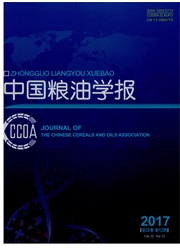

 中文摘要:
中文摘要:
为剖析冬末春初之际浅圆仓表层粮堆易发生结露机理,本研究以天津地区的钢板浅圆仓中所储的小麦粮堆为研究对象,重现了粮堆的温度场与水气分压场云图,显示了温度、湿度、微气流等主要非生物因子和粮堆自身热特性的影响而出现了温度和水气分压的分层现象。运用多场耦合理论分析得到,在温度差和水气分压压力差的作用下,粮堆中“冷区域”和“热区域”的微气流流动方向和水分的扩散方向会呈现出不同趋势。在其方向一致之处,水分扩散作用加强;反之水分扩散作用减弱。在低温季节的粮堆表层,两者方向相同,粮堆表层出现水分持续聚集现象;加之低温环境的影响,在粮堆表层易形成结露。本研究将为粮堆局部结露过程定量分析提供新视角。
 英文摘要:
英文摘要:
The stored wheat silo located in the Tianjin District was studied in the paper. The condensation of the grain surface in the steel squat silo of the last winter and next spring was analyzed, the cloud maps of grain tempera- ture and aqueous vapor pressure field were reappeared. And the phenomena of temperature and aqueous vapor pressure stratification was showed under the influence of temperature, humidity, micro - airflow and thermal characteristics of the grain. The status of stored grain was analyzed by multi - fields coupling theory. The temperature difference and aqueous vapor pressure difference made important contributions to micro - airflow and moisture diffusion. Thus the direction of micro - airflow and moisture diffusion in cold areas and hot ones would display different tendency. When they were in the same direction, effect of moisture diffusion was strengthened. And conversely it was weakened. In the surface of grain, the phenomenon of moisture aggregation happened in low - temperature season because of their same direction. Otherwise under the influence of low - temperature environment, the condensation of the grain surface would appear. The research would provide a new perspective for quantitative analysis of the partial condensation process in stored grain.
 同期刊论文项目
同期刊论文项目
 同项目期刊论文
同项目期刊论文
 期刊信息
期刊信息
